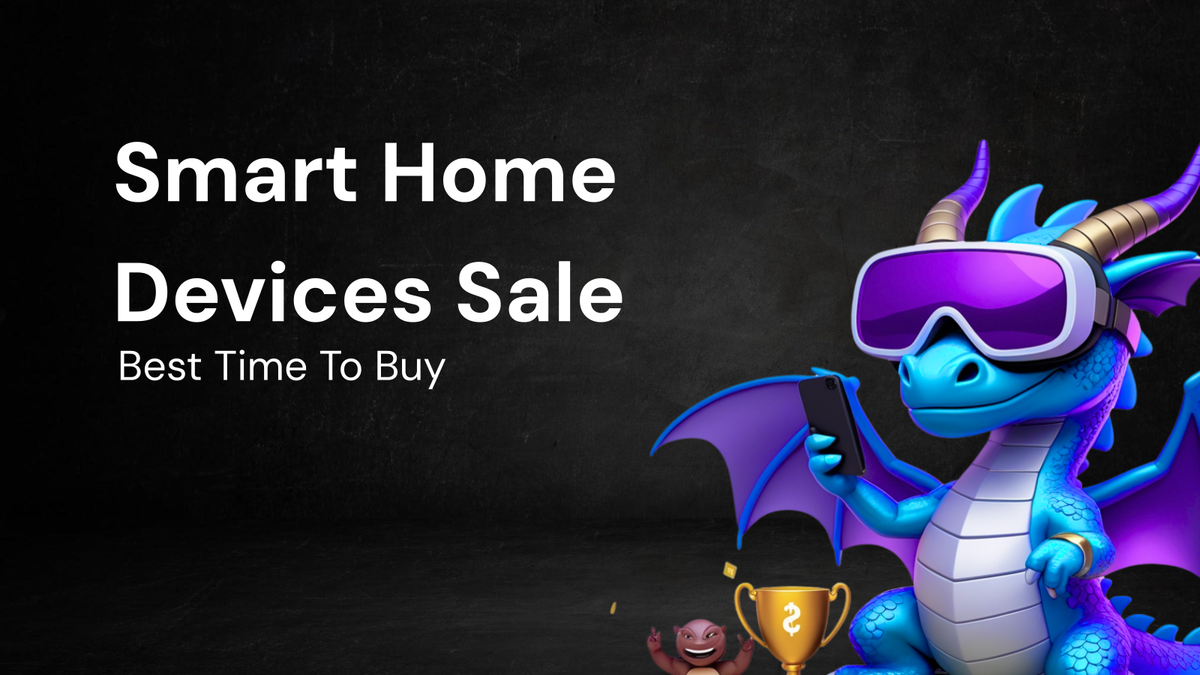Best Time To Buy for smart home devices with sale alerts

Best Time To Buy for Smart Home Devices with Sale Alerts
The allure of a connected, automated home is undeniable. From voice-controlled lighting to security systems accessible from your smartphone, smart home devices promise convenience, efficiency, and peace of mind. But with so many options and fluctuating prices, knowing when to buy can be as crucial as knowing what to buy. This comprehensive guide will equip you with the knowledge you need to snag the best deals on smart home devices, leveraging sale alerts and strategic timing to create your dream smart home without breaking the bank.
Why Timing Matters: Unlocking Significant Savings
The smart home market is competitive, with manufacturers constantly releasing new products and retailers vying for market share. This translates to frequent sales and promotions, often tied to specific events or times of the year. Buying during these periods can result in substantial savings, sometimes as much as 50% or more off the regular price. Understanding these patterns empowers you to be a savvy shopper and maximize your budget.
Understanding the Smart Home Device Landscape
Before diving into specific timing strategies, it's helpful to understand the broad categories of smart home devices and their typical price ranges:
- Smart Speakers & Displays: (Amazon Echo, Google Nest, Apple HomePod) - These are your central hubs for voice control, information, and entertainment. Expect prices to range from $30 (entry-level) to $300 (high-end with premium audio).
- Smart Lighting: (Philips Hue, LIFX, TP-Link Kasa) - Control your lights remotely, automate schedules, and create custom scenes. Bulbs range from $10 to $50 each, while starter kits with hubs can cost $70-$200.
- Smart Thermostats: (Nest, Ecobee, Honeywell) - Optimize your home's temperature for comfort and energy savings. Expect to pay $100-$300.
- Smart Security Systems: (Ring, Arlo, SimpliSafe) - Enhance your home's security with cameras, sensors, and professional monitoring options. Starter kits can range from $150 to $500+, with monthly subscription fees for professional monitoring.
- Smart Locks: (August, Schlage, Yale) - Control access to your home remotely and eliminate the need for physical keys. Prices range from $150 to $350.
- Smart Plugs & Switches: (TP-Link Kasa, WeMo, Amazon Smart Plug) - Turn ordinary appliances and lights into smart devices. Individual plugs and switches cost $15-$40.
- Smart Appliances: (Refrigerators, Ovens, Washers & Dryers) - High-end appliances with connected features for remote monitoring and control. Prices vary widely, from hundreds to thousands of dollars.
- Smart Entertainment: (Smart TVs, Streaming Devices, Soundbars) - Enhance your entertainment experience with streaming capabilities and voice control. Prices range from a few dollars for streaming sticks to thousands for high-end TVs.
Knowing these general price points will help you recognize a good deal when you see one.
The Prime Times: Seasonal Sales and Key Shopping Events
Certain times of the year consistently offer the best opportunities to buy smart home devices. These sales events are heavily promoted and often feature significant discounts across a wide range of products.
1. Black Friday & Cyber Monday (Late November):
- Why it's great: This is arguably the biggest shopping event of the year, with retailers offering deep discounts on virtually everything, including smart home devices. Expect to see record-low prices on popular items like smart speakers, lighting kits, security systems, and smart thermostats.
- What to expect: Intense competition, limited quantities, and potential for items to sell out quickly. Early planning and quick decision-making are crucial.
- Tips for success: Create a wishlist beforehand, monitor prices in the weeks leading up to the event, and be prepared to act fast when deals go live. Many retailers start their Black Friday sales earlier than the traditional Friday after Thanksgiving. Sign up for email alerts from your favorite retailers to get notified of early deals.
2. Amazon Prime Day (Typically July):
- Why it's great: Amazon's annual shopping event offers exclusive deals for Prime members, often rivaling Black Friday in terms of savings. Smart home devices, especially those compatible with Alexa, are heavily discounted.
- What to expect: Prime membership is required to access the best deals. Deals can be time-sensitive and limited in quantity.
- Tips for success: Become a Prime member (or take advantage of a free trial), monitor Amazon's website in the weeks leading up to Prime Day, and be prepared to add items to your cart quickly.
3. Holiday Sales (December):
- Why it's great: Retailers continue to offer discounts throughout December, hoping to capture last-minute holiday shoppers. While the deals may not be as deep as Black Friday, you can still find significant savings on smart home devices.
- What to expect: Less intense competition than Black Friday, but still important to shop early to ensure items are in stock.
- Tips for success: Compare prices across different retailers, look for bundled deals (e.g., a smart speaker with a smart bulb), and consider gift cards for future purchases.
4. Back-to-School Sales (Late Summer):
- Why it's great: While primarily focused on school supplies and electronics, back-to-school sales can also offer discounts on smart home devices, particularly those geared towards students or families.
- What to expect: Deals may be more targeted towards specific products or brands.
- Tips for success: Check retailers that cater to students and families, such as Best Buy, Target, and Walmart.
5. Memorial Day, Labor Day, and Other Holiday Weekends:
- Why it's great: These holiday weekends often feature sales events with discounts on a variety of products, including smart home devices.
- What to expect: Deals may be less extensive than Black Friday or Prime Day, but still offer opportunities to save.
- Tips for success: Monitor retailer websites and email newsletters for announcements of holiday weekend sales.
6. End-of-Season Sales:
- Why it's great: As manufacturers prepare to release new models, retailers often discount older inventory to make room. This is a great time to find deals on previous-generation smart home devices.
- What to expect: Limited selection and potential for items to be out of stock.
- Tips for success: Focus on retailers that frequently update their product lines, such as Best Buy and Amazon.
Beyond the Big Events: Strategic Timing Tactics
While seasonal sales are crucial, there are other strategic timing tactics you can employ to find deals on smart home devices throughout the year.
1. Following Product Release Cycles:
- The principle: When a new version of a smart home device is released, the previous generation typically sees a price drop.
- How to apply it: Research the release cycles of the specific devices you're interested in. For example, Apple typically releases new iPhones in September, which can lead to discounts on older models. Similarly, Amazon often updates its Echo devices in the fall.
- Caveats: The price drop may not be significant, especially for popular devices. The older generation may lack some of the features or improvements of the newer model.
2. Manufacturer Refurbished Options:
- The principle: Buying manufacturer-refurbished devices can save you a significant amount of money. These devices have been returned, inspected, and repaired to meet the manufacturer's original specifications.
- How to apply it: Check the manufacturer's website or authorized retailers for refurbished options. Amazon also has a dedicated section for "Amazon Renewed" products.
- Caveats: Refurbished devices may have cosmetic imperfections. Warranty coverage may be limited. Always buy from reputable sources to ensure quality and authenticity.
3. Open-Box Items:
- The principle: Open-box items are products that have been returned to a retailer but are still in good condition. They may have been opened but not used, or they may have been used briefly and then returned.
- How to apply it: Check the open-box section of retailers like Best Buy or local electronics stores.
- Caveats: Open-box items may have missing accessories or cosmetic imperfections. The return policy may be different than for new items.
4. Price Matching:
- The principle: Many retailers offer price matching, where they will match the price of a competitor if you find the same product for less.
- How to apply it: Research prices at different retailers and be prepared to show proof of the lower price. Check the retailer's price matching policy before making a purchase.
- Caveats: Price matching policies vary. Some retailers may not match prices from online-only retailers or auction sites.
5. Bundled Deals & Kits:
- The principle: Buying smart home devices in bundles or kits can often save you money compared to buying each item separately.
- How to apply it: Look for starter kits that include a hub and several smart devices, or bundles that combine related products (e.g., a smart thermostat with a smart vent).
- Caveats: Make sure you need all the items in the bundle. The savings may not be significant if you only need a few of the products.
6. Clearance Sales & Overstock:
- The principle: Retailers often clear out older inventory through clearance sales and overstock promotions.
- How to apply it: Check the clearance section of online and brick-and-mortar retailers.
- Caveats: Selection may be limited and items may be discontinued.
7. Utilizing Coupons & Promo Codes:
- The principle: Using coupons and promo codes can save you a percentage off the purchase price or offer free shipping.
- How to apply it: Search online for coupons and promo codes before making a purchase. Use browser extensions like Honey or RetailMeNot to automatically find and apply coupons.
- Caveats: Coupons may be expired or invalid. Promo codes may have restrictions or minimum purchase requirements.
Leveraging Sale Alerts: Your Secret Weapon
Sale alerts are your proactive tool for catching deals as soon as they appear. Instead of passively browsing, these tools notify you when prices drop on the items you want, ensuring you never miss a valuable opportunity.
1. Price Tracking Websites & Apps:
- Examples: CamelCamelCamel (for Amazon), Honey (browser extension), Keepa (for Amazon), Slickdeals.
- How they work: You enter the product URL or keyword and set a desired price. The website or app will track the price and send you an alert when it drops below your target.
- Benefits: Comprehensive price tracking, customizable alerts, historical price data.
- Considerations: Accuracy of data depends on the website's tracking capabilities. May require creating an account.
2. Retailer Email Newsletters:
- Examples: Amazon, Best Buy, Target, Walmart.
- How they work: You subscribe to the retailer's email newsletter and receive updates on sales, promotions, and new products.
- Benefits: Direct notifications from the retailer, access to exclusive deals and coupons.
- Considerations: Can be overwhelming with promotional emails. Need to actively manage your subscriptions.
3. Social Media Alerts:
- Examples: Following retailers and deal websites on Twitter, Facebook, or Instagram.
- How they work: Retailers and deal websites often announce sales and promotions on their social media channels.
- Benefits: Real-time updates, easy to share deals with friends and family.
- Considerations: Can be noisy and difficult to filter through irrelevant content.
4. IFTTT (If This Then That) Recipes:
- How it works: IFTTT allows you to create custom "recipes" that automate tasks based on specific triggers. You can set up a recipe that sends you an email or notification when a certain product's price drops on Amazon or another retailer.
- Benefits: Highly customizable, allows you to track prices across multiple retailers.
- Considerations: Requires some technical knowledge to set up.
5. Google Alerts:
- How it works: Set up Google Alerts for specific smart home device keywords (e.g., "Nest Thermostat sale," "Philips Hue discount"). Google will send you email notifications when those keywords appear in new online content.
- Benefits: Simple and easy to use, can track a wide range of keywords.
- Considerations: May generate irrelevant results.
Developing Your Smart Home Shopping Strategy
Finding the best time to buy smart home devices requires a combination of knowledge, planning, and proactive monitoring. Here's a step-by-step guide to developing your own smart home shopping strategy:
1. Define Your Needs and Budget:
- What problems are you trying to solve with smart home devices? (Security, energy savings, convenience, entertainment?)
- What specific devices are you interested in? (Be as specific as possible – e.g., "Nest Learning Thermostat" instead of just "smart thermostat").
- What is your overall budget for smart home devices?
2. Research Product Release Cycles:
- Find out when new versions of the devices you want are typically released. This will help you predict when older models might see price drops.
3. Identify Key Sales Events:
- Mark your calendar for Black Friday, Cyber Monday, Amazon Prime Day, and other holiday sales.
4. Sign Up for Email Newsletters and Social Media Alerts:
- Subscribe to email newsletters from your favorite retailers and follow them on social media.
5. Choose Your Price Tracking Tools:
- Select a price tracking website or app that meets your needs.
6. Create a Wishlist:
- Create a wishlist on Amazon or other retailers. This will make it easier to track prices and add items to your cart when they go on sale.
7. Monitor Prices Regularly:
- Check prices regularly, especially in the weeks leading up to major sales events.
8. Be Prepared to Act Fast:
- When you see a good deal, don't hesitate to buy it. Smart home devices often sell out quickly during sales events.
9. Consider Refurbished and Open-Box Options:
- Check for refurbished and open-box options to save even more money.
10. Don't Be Afraid to Negotiate:
- If you're buying a large number of smart home devices, try negotiating a discount with the retailer.
Conclusion: A Smarter Home, A Smarter Buyer
Building a smart home is an exciting journey, but it doesn't have to be an expensive one. By understanding the timing of sales, leveraging sale alerts, and employing strategic shopping tactics, you can create the connected home of your dreams without exceeding your budget. Remember to research your options, plan ahead, and be patient. The best deals are out there – you just need to know when and how to find them. Happy smart home shopping!




